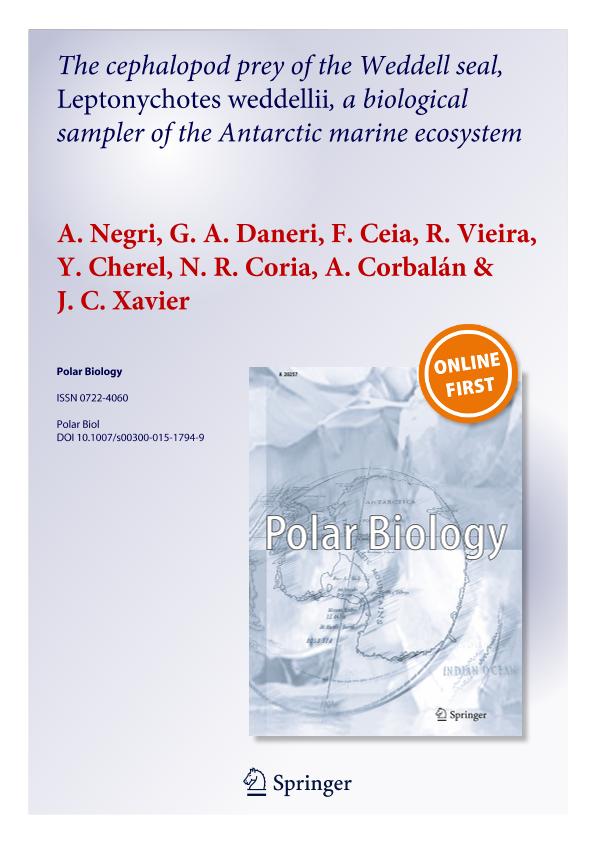Mostrar el registro sencillo del ítem
dc.contributor.author
Negri, Agustina

dc.contributor.author
Daneri, Gustavo Adolfo

dc.contributor.author
Ceia, F.
dc.contributor.author
Vieira, R.
dc.contributor.author
Cherel, Y.
dc.contributor.author
Coria, N. R.
dc.contributor.author
Corbalán, A.
dc.contributor.author
Xavier, J. C.
dc.date.available
2018-04-17T15:03:14Z
dc.date.issued
2016-03
dc.identifier.citation
Negri, Agustina; Daneri, Gustavo Adolfo; Ceia, F.; Vieira, R.; Cherel, Y.; et al.; The cephalopod prey of the Weddell seal, Leptonychotes weddellii, a biological sampler of the Antarctic marine ecosystem; Springer; Polar Biology; 39; 3; 3-2016; 561-564
dc.identifier.issn
0722-4060
dc.identifier.uri
http://hdl.handle.net/11336/42258
dc.description.abstract
Weddell seals, Leptonychotes weddellii, are important apex predators in the food web of the Antarctic marine ecosystem. However, detailed information on their trophic relationships with cephalopods is scarce. Moreover, cephalopods play a key role in the marine environment, but knowledge of their feeding habits is limited by lack of data. Here, we have combined the use of this seal as a biological sampler together with measurements of the stable isotopic signature of the beaks of their cephalopod prey. Thus, the aims of the present study were: (1) to examine in detail the cephalopod portion of the diet of Weddell seals by means of scat analysis and (2) to assess the habitat use and trophic level of the different cephalopod prey taxa identified. From January to February 2009, a total of 48 faecal droppings were collected at Hope Bay, Antarctic Peninsula. Cephalopods were mainly represented by beaks (n = 83) which were identified to the lowest possible taxonomic level. Furthermore, subsamples of beaks were separated for further isotopic analysis. Relative abundance of stable isotopes of carbon (δ13C) and nitrogen (δ15N) was determined by continuous-flow isotope-ratio mass spectrometry. Cephalopods were represented uniquely by octopods of the subfamily Eledoninae. Pareledone turqueti was the dominant prey species followed by the papillated Pareledone species group and Adelieledone polymorpha. We conclude that Weddell seals preyed primarily on benthic prey resources. Furthermore, the relatively similar δ13C and δ15N values in beaks of the three octopod prey taxa suggest that these share the same type of habitat and occupy similar trophic level positions.
dc.format
application/pdf
dc.language.iso
eng
dc.publisher
Springer

dc.rights
info:eu-repo/semantics/openAccess
dc.rights.uri
https://creativecommons.org/licenses/by-nc-sa/2.5/ar/
dc.subject
Antarctica
dc.subject
Leptonychotes Weddellii
dc.subject
Diet
dc.subject
Cephalopods
dc.subject
Stable Isotopes
dc.subject.classification
Otras Ciencias Biológicas

dc.subject.classification
Ciencias Biológicas

dc.subject.classification
CIENCIAS NATURALES Y EXACTAS

dc.title
The cephalopod prey of the Weddell seal, Leptonychotes weddellii, a biological sampler of the Antarctic marine ecosystem
dc.type
info:eu-repo/semantics/article
dc.type
info:ar-repo/semantics/artículo
dc.type
info:eu-repo/semantics/publishedVersion
dc.date.updated
2018-04-17T13:57:42Z
dc.identifier.eissn
1432-2056
dc.journal.volume
39
dc.journal.number
3
dc.journal.pagination
561-564
dc.journal.pais
Alemania

dc.journal.ciudad
Berlin
dc.description.fil
Fil: Negri, Agustina. Consejo Nacional de Investigaciones Científicas y Técnicas. Oficina de Coordinación Administrativa Parque Centenario. Museo Argentino de Ciencias Naturales "Bernardino Rivadavia"; Argentina. Ministerio de Relaciones Exteriores, Comercio Interno y Culto. Dirección Nacional del Antártico. Instituto Antártico Argentino; Argentina
dc.description.fil
Fil: Daneri, Gustavo Adolfo. Consejo Nacional de Investigaciones Científicas y Técnicas. Oficina de Coordinación Administrativa Parque Centenario. Museo Argentino de Ciencias Naturales "Bernardino Rivadavia"; Argentina
dc.description.fil
Fil: Ceia, F.. Universidad de Coimbra; Portugal
dc.description.fil
Fil: Vieira, R.. Universidad de Coimbra; Portugal
dc.description.fil
Fil: Cherel, Y.. Centre d’Etudes Biologiques de Chizé; Francia
dc.description.fil
Fil: Coria, N. R.. Ministerio de Relaciones Exteriores, Comercio Interno y Culto. Dirección Nacional del Antártico. Instituto Antártico Argentino; Argentina
dc.description.fil
Fil: Corbalán, A.. Ministerio de Relaciones Exteriores, Comercio Interno y Culto. Dirección Nacional del Antártico. Instituto Antártico Argentino; Argentina
dc.description.fil
Fil: Xavier, J. C.. Universidad de Coimbra; Portugal. British Antartic Survey; Reino Unido
dc.journal.title
Polar Biology

dc.relation.alternativeid
info:eu-repo/semantics/altIdentifier/doi/http://dx.doi.org/10.1007/s00300-015-1794-9
dc.relation.alternativeid
info:eu-repo/semantics/altIdentifier/url/https://link.springer.com/article/10.1007%2Fs00300-015-1794-9
Archivos asociados
